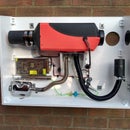Introduction: Extracting a Broken Threading Tap
While tapping an M4 (4mm) thread in a 10mm aluminium alloy plate, the tap snapped off. I tried a few methods of removing it, but without success - apart from the difficulty of gripping such a tiny tap in any way (cutting a slot, sliding wires down the flutes, etc), the tap seemed to be very firmly stuck!
I also considered punching the broken tap out of the aluminium sheet, but thought that the forces needed would damage/distort the sheet.
This Instructable suggests one way of dealing with the situation, and covers the first step in the sequence below:
- Create a 'core drill' and drill out the 4mm tap.
- Enlarge the hole and tap it to a much larger diameter (eg M10 - 10mm diameter thread).
- Create a plug by threading a scrap piece of aluminium bar to M10 using a die.
- Screw the plug into the hole, use thread lock, then trim the plug flush to the sheet.
- Re-drill the hole for the M4 thread and re-tap the hole - this time, being more careful!
I used a metal lathe to create the core drill, filed the teeth by hand with a triangular file and used a drill press to drill out the broken tap.
Step 1: Create the Core Drill 'blank' on the Lathe and Cut the Teeth
Core drill blank
Using a scrap of steel bar, I chucked it up on my lathe and drilled out a 4mm hole.
I turned the bar down to about 5mm diameter (giving a wall thickness ie tooth size) of about 0.5mm.
I took a small cut on the lathe to relieve the core drill behind the cutting edge. This would stop the drill from binding as it drilled down.
This was all done by eye - none of the dimensions seemed important!
Cutting the teeth
I cut the teeth with a tiny triangular file. I aimed the file at the centre of the hole and lowered my hand so that I was cutting upward and creating a tooth on the near side of the drill only. I left a very small flat on the top of the tooth, so that each tooth was the same height.
As this was for aluminium, I did not heat-treat the drill in any way.
Step 2: Drill-out the Broken Tap
Using WD40 as a lubricant, I aimed the drill to surround the broken tap, and slowly drilled down. I stopped fairly frequently to flush away the swarf.
On a couple of occasions, I re-sharpened the teeth. The drill stopped progressing at one stage - the core had broken off and clogged the inside of the drill. I punched the plug down inside the core drill and carried on!
The photo shows how the drill was left at the end of the process - not pretty. This is a one-off tool, I hope I never have to do anything similar again!
This seemed to be a successful strategy.













